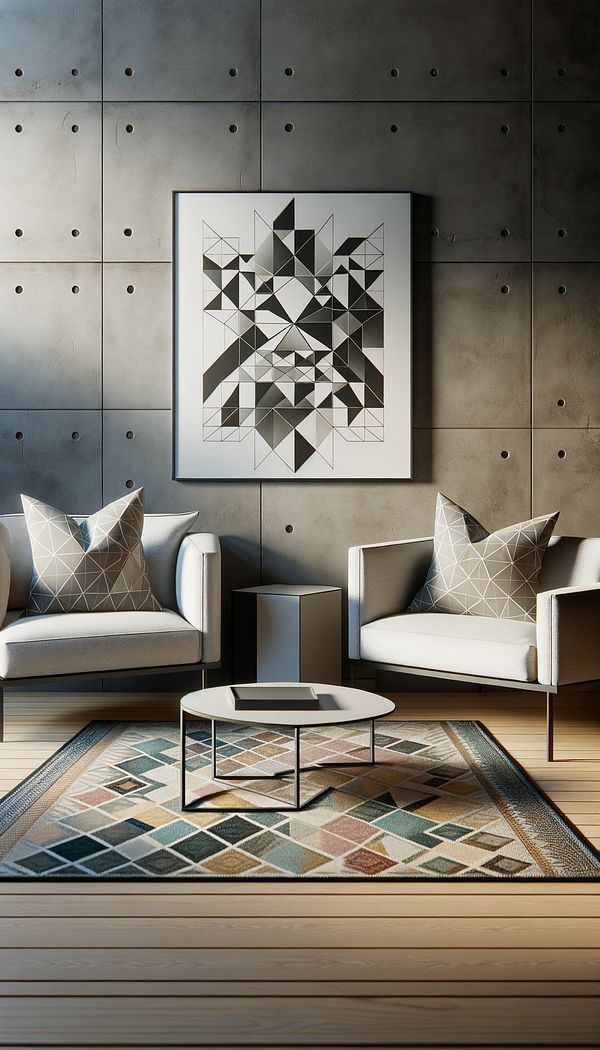What is Geometric?
Geometric refers to the use of shapes, lines, and forms in design.
Description
Geometric in interior design refers to the deliberate use and combination of shapes, lines, and forms to create patterns and visual interest in a space. These elements can be utilized in everything from fabrication and craftsmanship of furniture, to wall treatments and finishes, floor coverings and rugs, and even decorative objects. The basis of geometric design is in its simplicity and repetition, making it a versatile tool for designers to inject modernity and structure into a space planning and [[layout|space]].
The application of geometric patterns or shapes can range from subtle to bold. It can be employed to draw attention to a specific area, harmonize disparate elements within a room, or simply to add a layer of detail and complexity to an otherwise minimalistic design approach. Moreover, the geometric design is not confined to any singular design styles, but it can be adapted to fit a variety of aesthetics, from contemporary to traditional, making it a valuable aspect of interior design.
Geometric design not only impacts the visual appeal of a space but also influences its feel. For instance, rounded shapes can make a room feel more welcoming and relaxed, whereas sharp, angular shapes might introduce energy and a sense of dynamism. Understanding the psychological effects of shapes is crucial for interior designers when integrating geometric elements into their projects.
Usage
Geometric patterns are commonly found in decorative floor tiles, intricately designed rugs, wallpaper patterns, and fabric prints for cushions and upholstery. They are also evident in the architectural elements of a space, such as angular or circular windows, staircases, and furniture designs. Accessories like vases, lamps, and art pieces also frequently feature geometric shapes, offering an easy way to include this design element in any interior.
FAQs
-
Can geometric designs be used in any type of interior design style?
Yes, geometric designs are versatile and can be adapted to fit a wide range of interior design styles, from contemporary to traditional, by varying the shapes, colors, and scales used.
-
How can I incorporate geometric elements into my home without overwhelming the space?
Start with small, accent pieces like throw pillows, area rugs, or artwork that feature geometric patterns. Choose designs that complement the overall color scheme and style of your room. Gradually, you can introduce more or larger geometric elements based on your comfort level.
-
Do geometric patterns have any specific meaning?
Some geometric patterns can have cultural or historical significance, while others might be appreciated purely for their aesthetic value. The meaning often depends on the context in which they are used and the viewer's perspective.
Practical Application
When incorporating geometric elements into your design, consider the scale and color of the patterns in relation to the room size and existing decor. Use geometric designs to create focal points, add visual interest, or define different areas within a space. Remember, balance is key; too many geometric patterns can create visual clutter, so it's important to use them thoughtfully and proportionately.
-
Design Styles478 articles
-
Color & Patterns154 articles
-
Floor Coverings & Rugs7 articles
-
Decorating Principles & Elements330 articles
-
Wall & Ceiling Treatments35 articles
-
CamelbackA camelback is a high, rising curve on a piece of furniture that resembles the shape of a camel's hump.
-
Cast Iron FurnitureCast iron furniture refers to items of furniture made primarily from cast iron, a type of iron that has been melted, poured into molds, and allowed to solidify.
-
SconceA sconce is a wall-mounted light fixture.
-
SpringsSprings are components used in furniture construction for providing support and comfort.
-
Builder, HomeIn the context of interior design, home builder refers to a person or company specializing in constructing residential homes.
